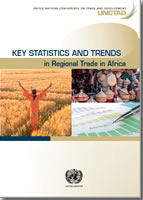
Africa has a big domestic market that possesses significant opportunities. Currently, Africa accounts for 2.9 per cent of the world production and 2.6 per cent of the world trade even though 16.3 per cent of the world population is living on the continent.
There are significant economic development gaps both between African and developed countries as well as among African countries. Poverty is still widespread in Africa where 32 out of 48 Least-Developed Countries (LDCs) are located.
Intra-African trade has increased in recent years to 15.4 per cent. Nevertheless, Asia and Europe are still the main trade partners of the continent. High dependence on trade in primary goods, high product and market concentration of exports, and weak regional production networks are among the main challenges of African counties.
Low performance in trade facilitation indicators is also hampering the development of trade and the economy in the region. For example, many African countries score low in e-commerce, linear shipping connectivity and doing business indicators.
Part of the difficulty in Africa is due to small, fractured and partly isolated markets. Many African countries resorted to development strategies after gaining independence that included the establishment of Regional Economic Communities (RECs). However, several RECs have overlapping memberships and seem to complicate instead of facilitating trade relationships among the African countries. African countries have been taking steps to integrate the continent through creating a continent-wide free trade area.
The Continental Free Trade Area (CFTA) framework agreement signed in 2018 by 44 African countries has ambitious long-term goals in deepening integration among African Union member States and building a prosperous and united Africa. Among the main objectives of the CFTA are the facilitation, harmonization and better coordination of trade regimes as well as the elimination of challenges associated with multiple and overlapping trade agreements across the continent. Through this agreement, African economies hope to strengthen the competitiveness of the local industries, realise economies of scale for domestic producers, better allocate resources and attract foreign direct investments.
This report is structured into three parts.
The first part presents an overview of Africa in the world economy and of intra-African trade.
The second part briefly summarizes the history of RECs in Africa.
The last part provides illustrative statistics on Africa’s trade in goods and services during the last decade.
The section includes various indicators of the trade structure, services trade, investment flows, trade facilitation, tariffs and non-tariff measures as well as exchange rates.
While the section presents some of the most commonly used trade indicators at the continent level, some other figures compare the structure and performance of eight main building blocks of the African Union: Arab Maghreb Union (AMU/UMA), Economic Community of West African States (ECOWAS), East African Community (EAC), Intergovernmental Authority on Development (IGAD), Southern African Development Community (SADC), Common Market for Eastern and Southern Africa (COMESA), Economic Community of Central African States (ECCAS), and Community of Sahel-Saharan States (CEN-SAD).


